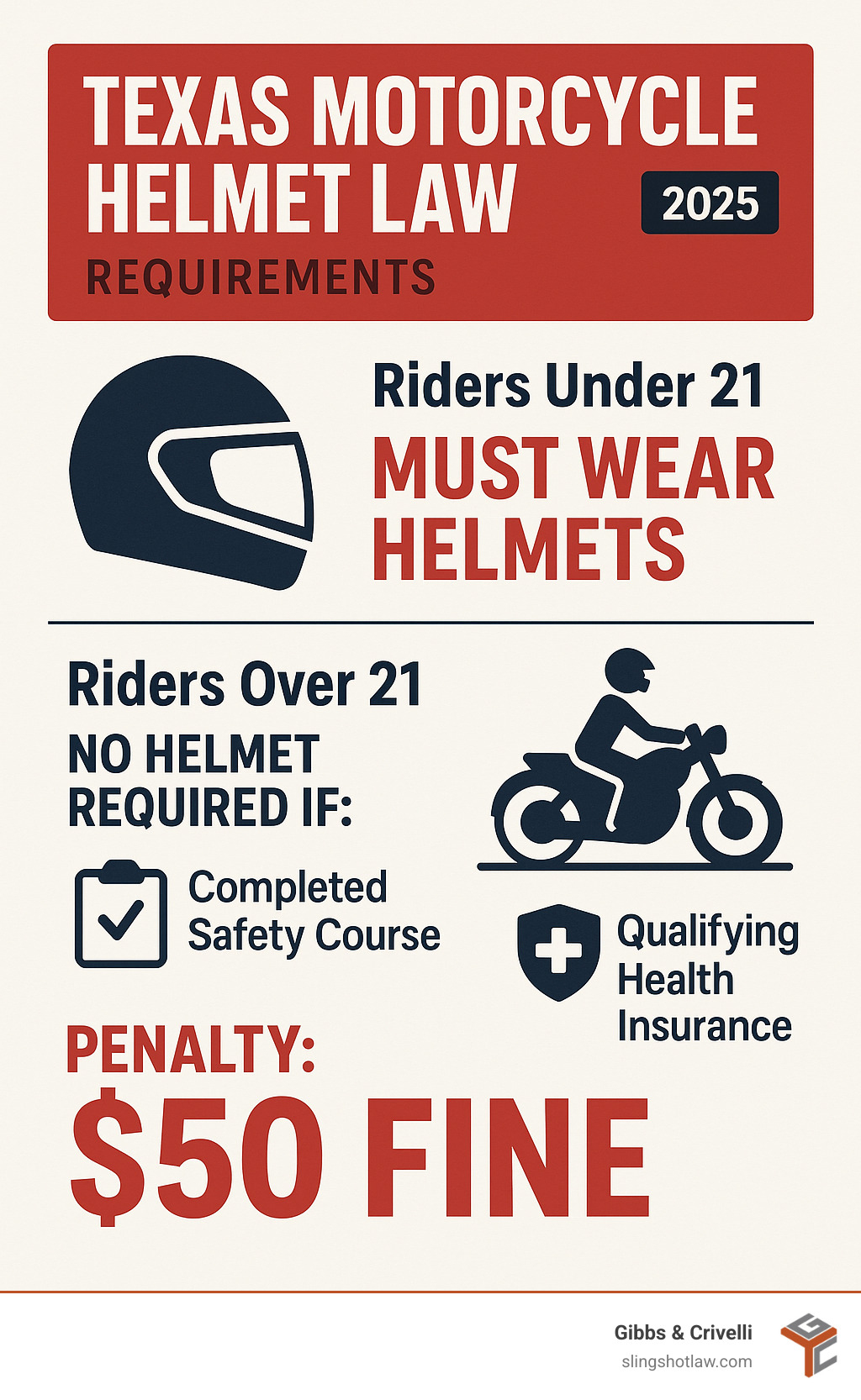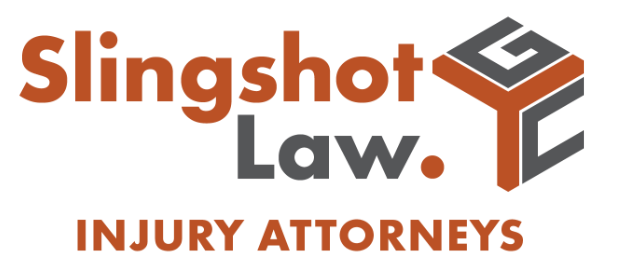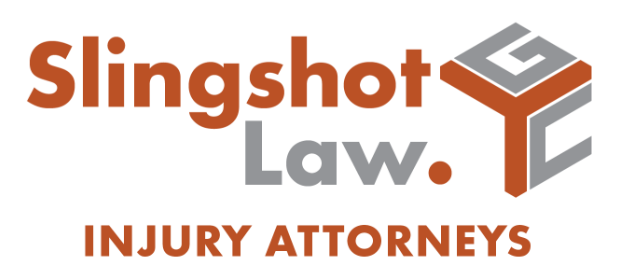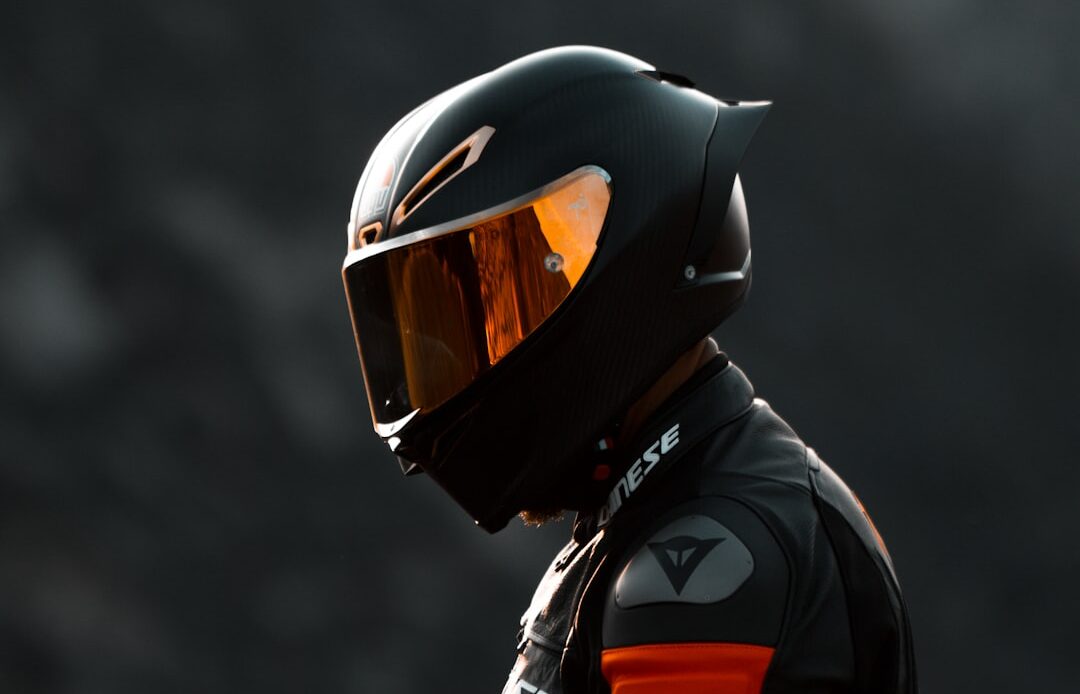The Bottom Line on Texas Motorcycle Helmet Laws
Is it illegal to ride a motorcycle without a helmet in Texas? The answer depends on your age and if you meet specific legal requirements. For riders in Austin, Cedar Park, and Round Rock, knowing the law can save you from a ticket and, more importantly, save your life.
Here’s the quick breakdown of Texas helmet law:
- Riders Under 21: You must wear a helmet. This applies to both operators and passengers.
- Riders Over 21: You can ride without a helmet IF you have either completed an approved motorcycle safety course OR carry health insurance that covers motorcycle injuries.
- Penalty: A violation is a misdemeanor punishable by a fine of up to $50.
While Texas law gives adult riders a choice, it’s a choice with consequences. Most motorcycle accidents in the Austin area result in serious head trauma. Even if you legally ride without a helmet, that decision can significantly impact a personal injury claim after a crash. Insurance companies will argue that you contributed to your own injuries, which can reduce the compensation you receive.
Whether you’re on MoPac or cruising the Hill Country, understanding the legal and safety implications of your helmet choice is critical.

Important is it illegal to ride a motorcycle without a helmet terms:
Understanding the Texas Helmet Exception: Are You Exempt?
Texas helmet law, outlined in Transportation Code Section 661.003, gives adult riders a choice, but it’s where many get confused about is it illegal to ride a motorcycle without a helmet. If you’re 21 or older, you may be exempt from wearing a helmet, but you must meet specific requirements and be able to prove it if stopped by police in Austin or Round Rock.
The two paths to exemption are completing an approved motorcycle safety course or carrying qualifying health insurance. The burden of proof is on you. If an officer pulls you over for a traffic violation, they can add a helmet citation if you can’t produce a safety course certificate or insurance card on the spot.
Texas has a “secondary enforcement” rule for helmet violations. This means Cedar Park police can’t pull you over just for not wearing a helmet. However, if they stop you for speeding or another infraction, the helmet issue can be added to your ticket.
Is it illegal to ride a motorcycle without a helmet if you’re over 21?
For riders over 21, it’s only legal to ride helmetless if you meet one of two requirements:
- Motorcycle Safety Course: You must complete a course approved by the Texas Department of Public Safety. It has to be an official course, and you must carry your completion certificate with you as proof.
- Health Insurance: You must have an insurance policy providing at least $10,000 in medical benefits for injuries from a motorcycle accident. Many riders in Texas are caught off guard here, as not all standard health plans cover motorcycle-related injuries. You must verify this coverage with your provider and carry proof of insurance while riding.
If you are over 21 but don’t meet either of these conditions, then yes, it is illegal for you to ride without a helmet.
What are the penalties for violating helmet laws in Texas?
A helmet violation in Texas is a Class C misdemeanor, carrying a fine of up to $50. While this may seem minor, the citation goes on your driving record. Insurance companies often see any traffic ticket as a sign of risky behavior, which can lead to higher premiums for your motorcycle and auto policies.
Dealing with a helmet citation in Cedar Park or another local court also means time and hassle. The best way to avoid this is to either wear a helmet or ensure you have the proper documentation for your exemption. Getting a ticket for something so preventable is an unnecessary expense and complication.
The High Stakes of Riding Helmetless: Safety and Legal Risks

While Texas law may give you the right to ride without a helmet, the laws of physics are unforgiving. When we represent clients from Austin to Cedar Park after motorcycle accidents, the difference in outcomes between helmeted and un-helmeted riders is often tragic. The question “is it illegal to ride a motorcycle without a helmet” feels secondary when facing a life-altering Traumatic Brain Injury (TBI).
Insurance companies are quick to use your helmet choice against you. Even when another driver is clearly at fault for a crash in Round Rock, their insurer will look for any reason to reduce their payout. Your decision not to wear a helmet, even if legal, becomes a key part of their strategy to blame you under the principle of comparative negligence.
How does not wearing a helmet affect an accident claim in Texas?
Texas uses a modified comparative negligence rule. If you are found 51% or more at fault for your injuries, you recover nothing. If you are 50% or less at fault, your compensation is reduced by your percentage of fault.
Here’s how it plays out: imagine a driver runs a red light in Austin and hits you. It’s their fault. But if you weren’t wearing a helmet and sustained a head injury, their insurance company will argue you are partially responsible for the severity of your injuries. They might claim a helmet would have prevented or lessened the injury, and they’ll try to pay you less as a result. It’s a cynical but common tactic we fight against for our clients.
This is why experienced legal representation is crucial. We know how to counter these arguments and focus the case on the other driver’s negligence, fighting for the full compensation you deserve.
What are the most common injuries for un-helmeted riders?
The statistics are sobering. According to scientific research on helmet effectiveness, helmets reduce the risk of death by 37% and the risk of head injury by 69%. Federal researchers at the National Highway Traffic Safety Administration (NHTSA) report similar findings, underscoring the life-saving power of a quality helmet. Our experience representing injured riders across Texas confirms this data. The most common injuries we see in un-helmeted riders include:
- Traumatic Brain Injuries (TBIs): These range from concussions, which can cause lasting cognitive issues, to severe TBIs that result in permanent disability and fundamentally alter a person’s life.
- Skull Fractures: In a crash, an unprotected head is vulnerable to severe fractures that can lead to brain damage or death.
- Facial Injuries: Broken jaws, shattered cheekbones, and severe dental damage are common without the protection of a full-face helmet. These injuries often require extensive reconstructive surgery and can cause permanent disfigurement.
- Severe Road Rash: Abrasions to the face and scalp can cause deep, permanent scarring, serving as a constant and painful reminder of the accident.
These injuries don’t just affect the rider; they place an immense burden on families in communities like Georgetown and Temple, who must cope with the long-term physical, emotional, and financial fallout.
Choosing Your Gear: More Than Just a Helmet
While the debate over is it illegal to ride a motorcycle without a helmet is important, choosing the right gear is a life-or-death decision. A quality helmet is the single most important piece of equipment you can own.
When shopping in Austin or Cedar Park, look for safety certifications. DOT-approved helmets meet the minimum federal safety standards. For even greater protection, look for Snell or ECE standard certifications, which involve more rigorous testing. The style of helmet also dictates the level of protection.
| Helmet Type | Description | Protection Level |
|---|---|---|
| Full-Face | Covers the entire head, including the chin and jaw. | Highest (recommended) |
| Modular (Flip-Up) | Combines features of full-face and open-face; chin bar can be raised. | High (when chin bar is down) |
| Open-Face (3/4) | Covers the top, back, and sides of the head, but leaves the face exposed. | Moderate (requires eye protection) |
| Half (1/2) | Covers only the top of the head. | Lowest (minimal protection) |
From our experience with injured riders, we’ve seen countless facial injuries that a full-face helmet could have prevented.
What should a Texas rider look for in a motorcycle helmet?
When buying a helmet, prioritize these features:
- Proper Fit: A helmet should be snug all around without creating pressure points. It shouldn’t move independently when you shake your head. Take your time trying on helmets at a reputable shop in Round Rock or Georgetown.
- DOT Sticker: This is the non-negotiable minimum safety standard.
- Comfort and Ventilation: A well-ventilated helmet is essential for staying cool and focused during hot Texas summers.
- Visor Quality: Look for a scratch-resistant, anti-fog visor for clear visibility.
- Age: Helmets should be replaced every 3-5 years, as materials degrade over time. They must also be replaced after any impact, even if no damage is visible.
Avoid questionable online sellers and stick to reputable dealers to avoid dangerous counterfeit helmets.
What other protective gear is essential for riding?
Your helmet needs a strong supporting cast. We recommend an “all the gear, all the time” approach. Essential gear includes:
- Jackets and Pants: Choose leather or abrasion-resistant textiles, preferably with built-in armor. Bright colors improve visibility on busy roads like MoPac.
- Gloves: Protect your hands from impact and road rash while improving grip.
- Boots: Sturdy, over-the-ankle boots protect against crushing injuries and provide ankle support.
- Eye Protection: This is mandatory in Texas if your bike doesn’t have a windshield. Use a quality visor, goggles, or shatter-resistant glasses.
- High-Visibility Clothing: Fluorescent colors make you more visible to other drivers, especially at dawn and dusk.
Riding Beyond Texas? Know the Helmet Laws in Neighboring States
If you’re planning a trip from Austin to another state, the answer to is it illegal to ride a motorcycle without a helmet changes the moment you cross the border. What’s legal in Texas can get you a ticket elsewhere. For Texas riders, it’s crucial to know the laws of our neighboring states.
Unlike Texas’s “secondary enforcement” rule (where police can’t pull you over just for a helmet violation), many neighboring states have “primary enforcement.” This means an officer can stop you solely for not wearing a helmet.
How do helmet laws vary in states bordering Texas?
Before you ride out from Harker Heights or Killeen, be aware of these key differences:
- Louisiana: Has a universal helmet law. All riders and passengers, regardless of age or insurance, must wear a helmet. There are no exceptions.
- Arkansas: Has a partial helmet law. Riders and passengers under the age of 21 must wear a helmet.
- Oklahoma: Has a partial helmet law, but it only applies to riders and passengers under the age of 18.
- New Mexico: Also has a partial helmet law requiring helmets for all riders and passengers under the age of 18.
Because the rules change so frequently at state lines, always do your research before a long-distance ride. A quick check of the laws in your destination state can save you from a costly ticket and legal hassle. Ignorance of the local law is no excuse.
Frequently Asked Questions about Texas Helmet Laws
We get many questions from riders across Austin and Cedar Park about Texas helmet laws. Here are answers to the most common ones regarding is it illegal to ride a motorcycle without a helmet.
Can a passenger ride without a helmet in Texas?
Passengers must follow the exact same rules as the motorcycle operator. There are no special exemptions for passengers.
- Under 21: A passenger must wear a helmet. No exceptions.
- 21 and Older: A passenger can ride without a helmet only if they also meet one of the two legal exemptions: proof of completing an approved safety course or proof of having at least $10,000 in qualifying health insurance.
As the operator, you are responsible for ensuring your passenger complies with the law. Before giving someone a ride in Round Rock or Temple, confirm they are legally covered.
Does my health insurance policy meet the Texas helmet law requirement?
This is a critical question. The law requires at least $10,000 in medical benefits for motorcycle accident injuries, but many standard health insurance policies have exclusions for what they deem “high-risk activities” like motorcycling.
Do not assume you are covered. You must verify your policy. Call your insurance provider and ask them directly: “Does my policy provide at least $10,000 in medical coverage for injuries sustained in a motorcycle accident?” Get the answer in writing if possible. Riding in Pflugerville with an invalid policy is the same as having no exemption at all.
What is a DOT-approved helmet?
A DOT-approved helmet is one that meets the minimum safety standards (FMVSS No. 218) set by the U.S. Department of Transportation. You can identify a compliant helmet by the “DOT” sticker on the back.
Be wary of “novelty” helmets. These thin, lightweight helmets may look stylish but offer virtually no protection in a crash and do not satisfy legal requirements. When it comes to your safety, always choose a helmet that is genuinely DOT-certified. It’s designed to save your life, and that’s a worthy investment.
Injured in a Motorcycle Accident? We Can Help.
There’s a unique freedom to riding a motorcycle through Texas, from the Hill Country near Austin to the streets of Cedar Park and Killeen. We understand that connection to the road.
But accidents happen, often due to drivers who fail to see motorcyclists. Even if you follow every rule and understand is it illegal to ride a motorcycle without a helmet, a crash can leave you with serious injuries. When you’re hurt, the last thing you need is a battle with an insurance company.
Insurance adjusters often start working against you immediately. They will use any excuse—including your legal choice not to wear a helmet—to reduce your claim or shift blame. They may downplay your injuries, question your medical care, and pressure you into a lowball settlement that won’t cover your long-term needs.
That’s where Gibbs & Crivelli comes in. We fight these battles for injured motorcyclists across Central Texas, from Austin and Round Rock to Temple and San Marcos. We know the insurance company playbook and how to counter their tactics to protect our clients.
Our team handles everything, from accident investigation to negotiating with aggressive adjusters. Our goal is to secure the fair compensation you deserve for your medical bills, lost wages, and pain and suffering. We believe you deserve a powerful advocate in your corner.
If you or a loved one was hurt in a motorcycle accident anywhere in our Texas communities, don’t face the insurance companies alone. They have a team of lawyers; you should too.
Get help with your Austin motorcycle accident claim today. Let us be your slingshot against the giants.




